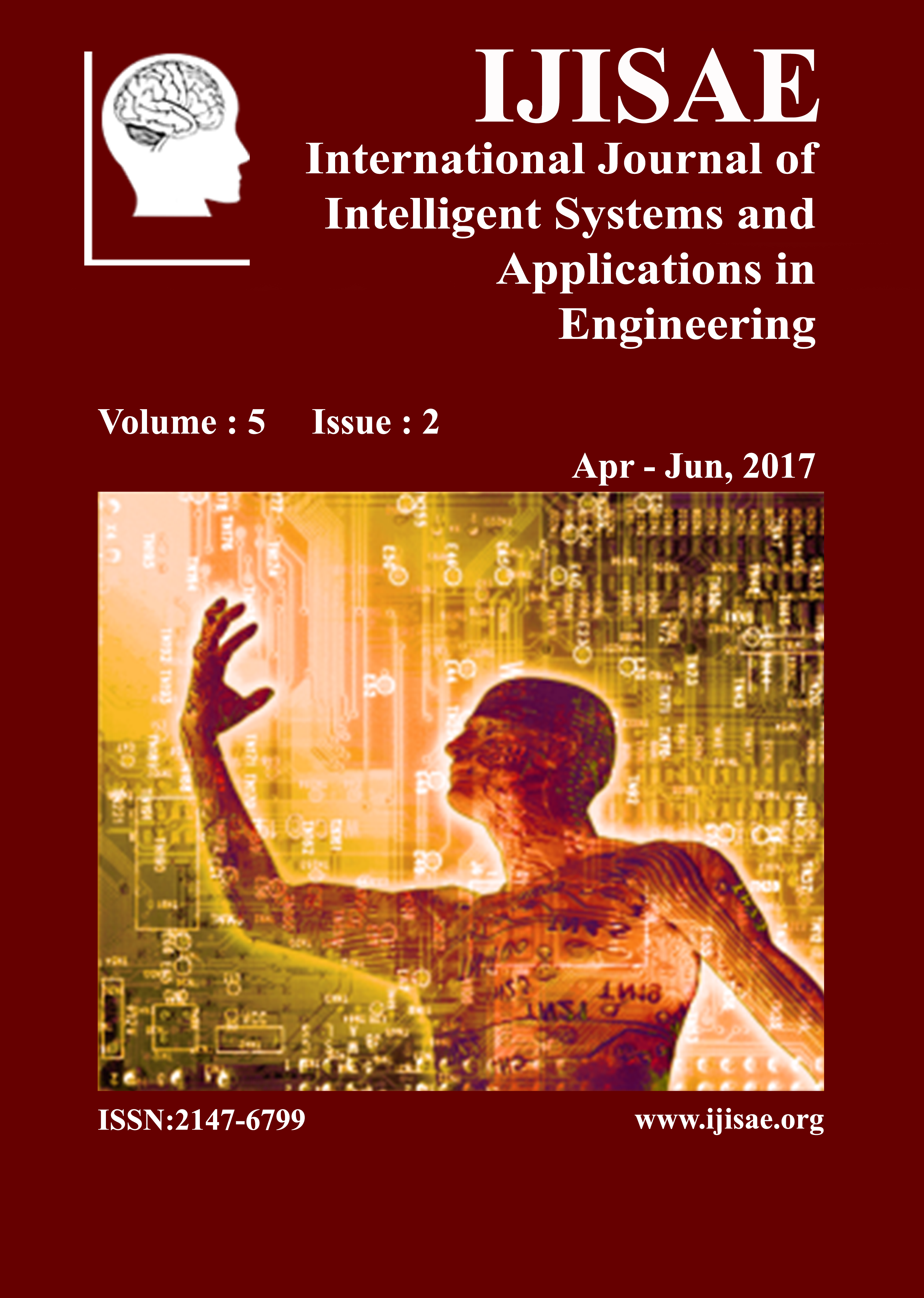Comparison of Classification Techniques on Energy Efficiency Dataset
DOI:
https://doi.org/10.18201/ijisae.2017534722Keywords:
Data mining, classifications, energy efficientAbstract
The definition of the data mining can be told as to extract information or knowledge from large volumes of data. Statistical and machine learning techniques are used for the determination of the models to be used for data mining predictions. Today, data mining is used in many different areas such as science and engineering, health, commerce, shopping, banking and finance, education and internet. This study make use of WEKA (Waikato Environment for Knowledge Analysis) to compare the different classification techniques on energy efficiency datasets. In this study 10 different Data Mining methods namely Bagging, Decorate, Rotation Forest, J48, NNge, K-Star, Naïve Bayes, Dagging, Bayes Net and JRip classification methods were applied on energy efficiency dataset that were taken from UCI Machine Learning Repository. When comparing the performances of algorithms it’s been found that Rotation Forest has highest accuracy whereas Dagging had the worst accuracy.Downloads
References
R. Andrews, J. Diederich, and A. B. Tickle, “Survey and critique of techniques for extracting rules from trained artificial neural networks,” Knowledge-Based Syst., vol. 8, no. 6, pp. 373–389, 1995.
P. Gray and H. J. Watson, “Present and Future Directions in Data Warehousing,” Data Base Adv. Inf. Syst., vol. 29, no. 3, pp. 83–90, 1998.
I. Saritas, M. Koklu, and K. Tutuncu, “Performance of Classification Techniques on Parkinson’s Disease,” Int. J. Adv. Sci. Eng. Technol., vol. 5, no. 2, pp. 9–13, 2017.
M. Langaas, “Discrimination and classification. Technical report. Department of Mathematical Sciences, The Norwegian Institute of Technology. Norway,” 1995.
M. Koklu and K. Tutuncu, “Classification of Chronic Kidney Disease With Most Known data Mining Methods,” Int. J. Adv. Sci. Eng. Technol., vol. 5, no. 2, pp. 14–18, 2017.
J. Han, M. Kamber, and J. Pei, “Data Mining: Concepts and Techniques. Elsevier,” 2011.
M. Castelli, L. Trujillo, L. Vanneschi, and A. Popovic, “Prediction of energy performance of residential buildings: A genetic programming approach,” Energy Build., vol. 102, pp. 67–74, 2015.
S. S. Gilan and B. Dilkina, “Sustainable Building Design: A Challenge at the Intersection of Machine Learning and Design Optimization,” pp. 101–106, 2015.
S. A. Kalogirou, “Artificial neural networks in energy,” Int. J. Low Carbon Technol., vol. 1, no. 3, pp. 201–216, 2006.
A. Tsanas and A. Xifara, “Accurate quantitative estimation of energy performance of residential buildings using statistical machine learning tools,” Energy Build., vol. 49, no. August 2011, pp. 560–567, Jun. 2012.
“Blake A.C.L. and Merz C.J. (1998). University of California at Irvine Repository of Machine Learning Databases, https://archive.ics.uci.edu/ml/datasets/Energy+efficiency, Last Access: 20.01.2017.”
R. Arora and Suman, “Comparative Analysis of Classification Algorithms on Different Datasets using WEKA,” Int. J. Comput. Appl., vol. 54, no. 13, pp. 21–25, 2012.
K. Tutuncu and M. Koklu, “Comparison of Classification Techniques on Dermatological Dataset,” Int. J. Biomed. Sci. Bioinforma., vol. 3, no. 1, pp. 10–13, 2016.
J. Abellán and J. G. Castellano, “A comparative study on base classifiers in ensemble methods for credit scoring,” Expert Syst. Appl., vol. 73, pp. 1–10, 2017.
E. Bauer, R. Kohavi, P. Chan, S. Stolfo, and D. Wolpert, “An Empirical Comparison of Voting Classification Algorithms: Bagging, Boosting, and Variants,” Mach. Learn., vol. 36, no. August, pp. 105–139, 1999.
L. Breiman, “Bagging predictors,” Mach. Learn., vol. 24, no. 2, pp. 123–140, 1996.
Z. Barutcuoglu, “A Comparison of Model Aggregation Methods for Regression.,” Icann, pp. 76–83, 2003.
M. Koklu and K. Tutuncu, “Performance of Classification Techniques on Medical Datasets,” Int. J. Biomed. Sci. Bioinforma., vol. 3, no. 1, pp. 5–9, 2016.
P. Melville and R. J. Mooney, “Diverse ensembles for active learning,” in Twenty-first international conference on Machine learning - ICML ’04, 2004, p. 74.
S. Satu, T. Akter, and J. Uddin, “Performance Analysis of Classifying Localization Sites of Protein using Data Mining Techniques and,” pp. 860–865, 2017.
M. Hall, E. Frank, G. Holmes, B. Pfahringer, P. Reutemann, and I. H. Witten, “The WEKA data mining software,” ACM SIGKDD Explor. Newsl., vol. 11, no. 1, p. 10, Nov. 2009.
G. Kaur and A. Chhabra, “Improved J48 Classification Algorithm for the Prediction of Diabetes,” Int. J. Comput. Appl., vol. 98, no. 22, pp. 13–17, 2014.
M. Panda, A. Abraham, and M. R. Patra, “Hybrid intelligent systems for detecting network intrusions,” Secur. Commun. Networks, vol. 8, no. 16, pp. 2741–2749, Nov. 2015.
D. Y. Mahmood and M. A. Hussein, “Intrusion Detection System Based on K-Star Classifier and Feature Set Reduction,” Int. Organ. Sci. Res. J. Comput. Eng. Vol, vol. 15, no. December, pp. 107–112, 2013.
F. Alam and S. Pachauri, “Comparative Study of J48 , Naive Bayes and One-R Classification Technique for Credit Card Fraud Detection using WEKA,” Adv. Comput. Sci. Technol., vol. 10, no. 6, pp. 1731–1743, 2017.
K. Wang, “Outcome Prediction of DOTA2 Based on Naive Bayes Classifier,” no. 1994, pp. 4–6, 2017.
B. Trivedi and N. Kapadia, “Modified Stacked Generalization with Sequential learning,” Int. J. Comput. Appl., pp. 38–43, 2012.
W. W. Cohen, “Fast effective rule induction,” Proc. Twelfth Int. Conf. Mach. Learn., vol. 95, pp. 115–123, 1995.
Downloads
Published
How to Cite
Issue
Section
License
All papers should be submitted electronically. All submitted manuscripts must be original work that is not under submission at another journal or under consideration for publication in another form, such as a monograph or chapter of a book. Authors of submitted papers are obligated not to submit their paper for publication elsewhere until an editorial decision is rendered on their submission. Further, authors of accepted papers are prohibited from publishing the results in other publications that appear before the paper is published in the Journal unless they receive approval for doing so from the Editor-In-Chief.
IJISAE open access articles are licensed under a Creative Commons Attribution-ShareAlike 4.0 International License. This license lets the audience to give appropriate credit, provide a link to the license, and indicate if changes were made and if they remix, transform, or build upon the material, they must distribute contributions under the same license as the original.










